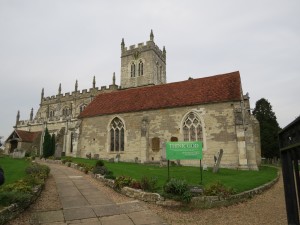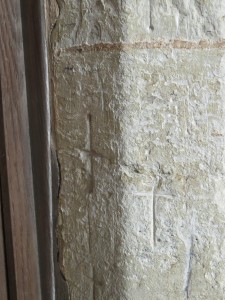You don’t have to look very hard to find history in England. It hits you in the face as you meander along the lanes or pass through tiny villages. It’s the buildings that hold the biggest surprises though, and there’s no denying the Romans/Saxons/Normans knew a thing or two about constructing buildings to last. Nowhere is this more evident than in Wootton Wawen, where stands the oldest surviving Saxon church in Warwickshire.
St Peter’s stands on the site of a Benedictine monastery established in 700AD, but long before that, in the Late-Bronze and Iron Ages, the people created a ‘homeland’ called Wildwood. They transformed the heavy soil and gravel of the district into pasture, and established farms. These were connected by paths which soon became cart tracks and, eventually, roads. Over time the name of the locality changed from the original Wudutun through Wotone, Waghanes Wotton, Wauneswotton and Waweneswotton, Wavens Wotton to today’s Wootton Wawen.
A Norman priory was built here in the 1100s and the two Benedictine monks distributed bread to the poor and sick twice a week during the 1130s. There’s a story told about one prior, Peter de Altaribus who, in 1281 attacked his monk, sold all the church plate, refused to give charity to the poor and hunted illegally on the lord’s land. For such nose-thumbing he was excommunicated and banished.
The church itself bears witness to some important events. 12th Century reminders that not all who embarked on the Crusades returned are revealed in the small crosses carved in the stone surrounding the doorway. Upon leaving, crusaders carved the vertical post of the cross, completing the horizontal only upon their return. There are several incomplete crosses.
In the mid-13th Century reconstruction began on the ageing building, with the intention of replacing the early Anglo-Saxon and Norman church with an English tower, enlarged chancel and transepts but the work was largely abandoned.
A recent addition is the board recording all the vicars of Wootton Wawen since Richard the Lionheart’s time. Such record-keeping is something of an eye-opener. There are almost 70 names on the board, from 1190 to the present day.
Faintly visible on the Lady Chapel wall are 14th Century paintings depicting the Seven Deadly Sins. I remember seeing paintings on the walls of the Lady Chapel in Cirencester several years ago, but I believe they were later decorations.
I’m not a history buff, but I do so enjoy the surprise encounters with such historical events and people. Warwickshire – and Warwick itself – has been so involved in the making of English history that you almost don’t need to look any further to discover the history of the entire nation.


